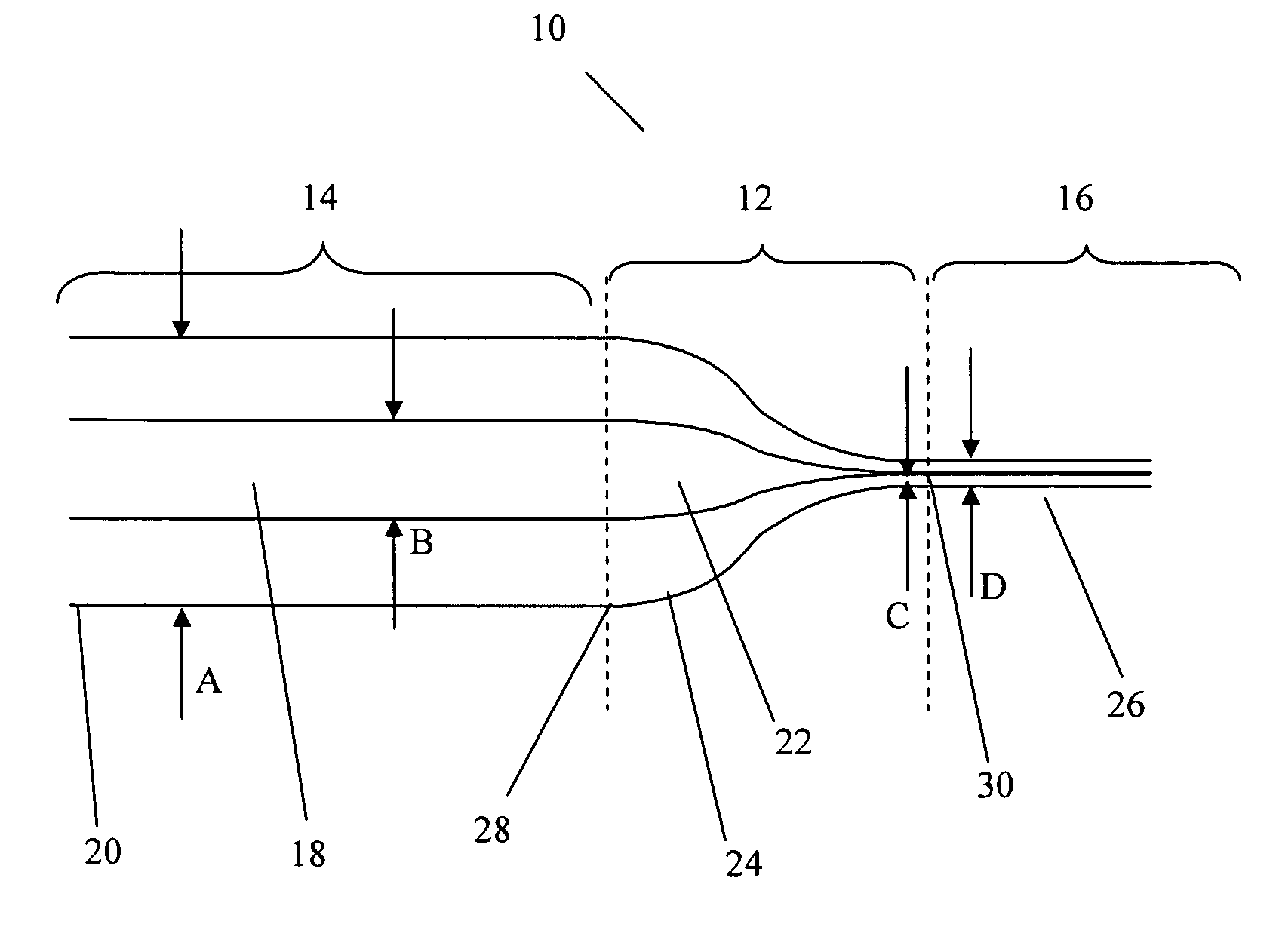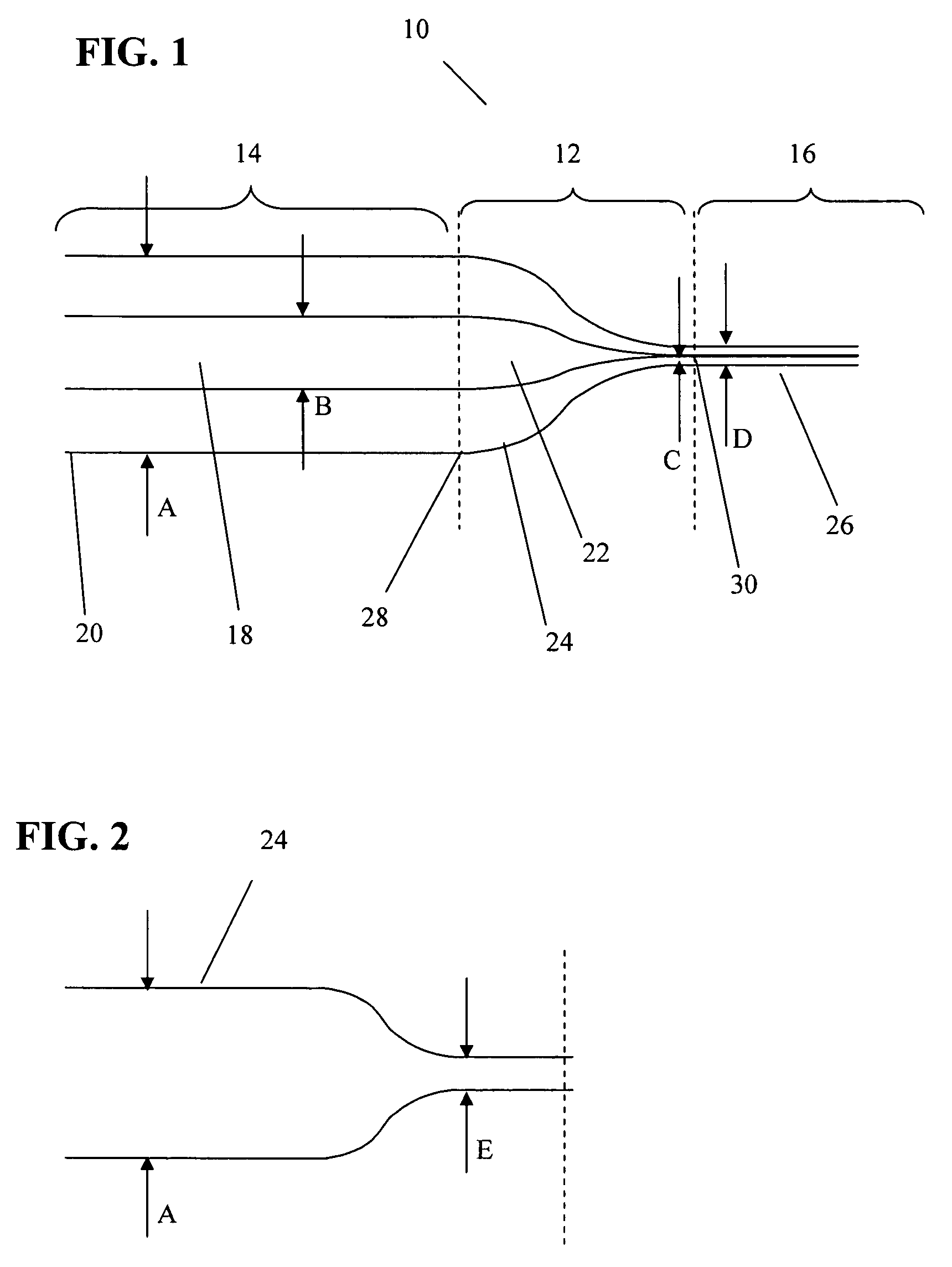Optical fiber coupler with low loss and high coupling coefficient and method of fabrication thereof
a technology of optical fiber couplers and coupling coefficients, applied in the field of couplers, can solve the problems of increasing insertion losses, reducing the coupling coefficient at each interface, and significant challenges in interfacing optical waveguide devices. achieve the effect of low loss and high coupling coefficient interfa
- Summary
- Abstract
- Description
- Claims
- Application Information
AI Technical Summary
Benefits of technology
Problems solved by technology
Method used
Image
Examples
first embodiment
[0030]Referring now to FIG. 1, an inventive optical fiber coupler 12, is shown as part of an interface assembly 10. The coupler 12 serves as an interface between an optical fiber 14 (having an optical fiber core 18 and a cladding 20), and an optical waveguide device 16. Before describing the novel coupler 12 in greater detail, it would be helpful to discuss the optical fiber 14, and the optical waveguide device 16 in greater detail.
[0031]The optical fiber 14 may be a conventional low-index-contrast optical fiber with the core 18 and the cladding 20 (as shown in FIGS. 7A and 7B). As shown in FIG. 1, the optical fiber core 18 has a size B, while the optical fiber cladding 20 has a size A. An additional parameter of the optical fiber 14, is shown in FIG. 7B, as an angle θ, defining a “cone” within which light leaves the fiber core 18. Accordingly, the numerical aperture of the fiber 14 may be expressed as a sin(θ).
[0032]Alternately, the optical fiber 14, may be a polarization maintaini...
second embodiment
[0041]Referring now to FIG. 3, the coupler of the present invention is shown as a coupler 50, serving as an interface between an optical fiber 60, and an optical waveguide device 70. The optical fiber 60, and the optical waveguide device 70 are substantially similar to the fiber 14 and optical waveguide device 16 of FIG. 1, except that the medium surrounding these components is an additional cladding applied to each respective component 60, 70.
[0042]Similarly, the coupler 50, is equivalent to the coupler 12 of FIG. 1, except that the medium surrounding a core 52 and a cladding 54 thereof, is configured as a second cladding 56 (with the refractive index nm) surrounding the cladding 54. As the reduction profile is applied, the core 52 is reduced from size H to size I, the cladding 54 is reduced from size G to size J, while the second cladding 56 is reduced from size F to size K. This arrangement ensures that the second cladding 56 isolates and protects the reduced size cladding 54 fro...
PUM
| Property | Measurement | Unit |
|---|---|---|
| refractive index | aaaaa | aaaaa |
| cladding size | aaaaa | aaaaa |
| refractive indices | aaaaa | aaaaa |
Abstract
Description
Claims
Application Information
 Login to View More
Login to View More - R&D
- Intellectual Property
- Life Sciences
- Materials
- Tech Scout
- Unparalleled Data Quality
- Higher Quality Content
- 60% Fewer Hallucinations
Browse by: Latest US Patents, China's latest patents, Technical Efficacy Thesaurus, Application Domain, Technology Topic, Popular Technical Reports.
© 2025 PatSnap. All rights reserved.Legal|Privacy policy|Modern Slavery Act Transparency Statement|Sitemap|About US| Contact US: help@patsnap.com



